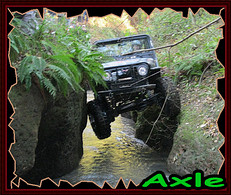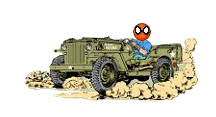This write-up will be posted here in sections as I find the time to do them. Please bare with me it will not take all that long.
Preface
About 18 months ago I began designing and building various ways of shifting an Ox Locker without the Ox Shifter and Cable.
Why?
Well to be honest it wasn’t because I have ever experienced any problems with the shifter or cable, but rather more then a few other folks had, and in truth I am not nuts about the cable design myself.
I built three different shifting systems, one air powered, one electric and one hydraulically powered.
All worked, but as my friend Blaine so kindly points out to me I have a tendency to sometimes make things more complex then they need to be. (Everyone needs someone to keep him or her honest and simple. Thanks Blaine.)
This write-up is not about my designs to convert an Ox Locker to be Air Operated, but rather will, for the most part describe a super simple system developed by a young man named John Lemieux.
Blaine put me in touch with John. He owns a shop in Corona, CA called All Four Wheel Drive.
John is a world-class gear man and was already working on a conversion design to eliminate the Ox Cable and Shifter Assembly. After talking with John and receiving a very generous amount of his time, both over the phone and during a visit to his shop in Corona I scraped my designs and adopted his.
To date, John has been running his D30/D44 and I, my D35 Ox locker, for more then a year using this design without any failures, popping ,or breakage of any kind.
Please clearly understand; while I am documenting this How-To-Do-It, full credit belongs to John Lemieux.
I believe John is being very generous, considering he makes his living doing this kind of stuff, in allowing me to put this information out into the public domain on this forum. For this reason I feel justified in plugging his shop with his contact information. I hope he doesn’t mind. I don’t think most folks here will mind either.
John Lemieux
All Four Wheel Drive
21765 Temeseal Canyon Rd
Corona, CA
(909) 277-1037
all4wd1@aol.com
Thanks John.
Air Ox Conversion Overview
Here is a picture and a brief over view of my Super 35 Ox Locker converted to air operations..

There are only TWO (2) Main “Operating Parts” to be added to the Ox Locker to convert it to air operations, an air cylinder outside the cover and an Allen Cap Bolt threaded into the Ox Shift Fork.
In the above picture, sticking out of the Ox Cover is a simple air cylinder.
Notice there are two airlines. The line on the right is the air pressure line. It goes to my ARB Compressor. (It also goes to my York Compressor as a back up system. I like redundancies.)
The line on the left is just a vent hose. I have it running up along side the differential vent hose.
Both lines are actually nylon (hardline) air hose covered in 3/8-inch fuel line hose for protection. (I don’t know if this is needed or not but it makes me feel better.)
The air cylinder is made by SpeedAir and is available from Grainger for $17.85 The part number is 6W073. (See complete parts list later in this document.)
The interchange chart says that the Bimba air cylinder # 091-D is an exact replacement air cylinder if you can’t get the SpeedAir unit.
This air cylinder is a double acting cylinder with 1-inch stroke, yet only the “push out” side is being used in this design.
The cylinder is nose mounted via a 5/8” x 18-tpi threads to the OX Locker cover. (Folks it simply screws right in!)
A stainless steel piston having 5/16 –24 thread extends from the air cylinder when air pressure is applied. The threads on this piston are not used. Rather the end of the cylinder piston simply pushes against a Stainless Steel (hardened) Allen Cap Bolt which threads into the Ox Shift Fork.
That’s basically it folks. That’s the meat.
It takes a minimum of 48 PSI of air pressure to operate and lock the OX reliably without any popping. I have tested this extensively to see how low the pressure could be taken.
My current ARB in the front is set for 85 PSI. So I have that same pressure going to the Air Operated OX Locker now.
For the size air cylinder used in this design, 1 PSI of air pressure into the cylinder will result in 0.89 Pounds of Pressure available at the air cylinder piston.
So at 85-PSI air in I have 75.6 Pounds of pressure holding the OX Locker in the locked position.
When the air pressure is released from the Air Cylinder the Ox Locker (Cam Springs) push the cylinder back out, much the same way they do with the new shifter assembly.
The vent hose (left hose in the above picture) enables this to happen without any pressure build-up to be overcome.
Here is a picture of all that goes inside the Ox Cover.

On top I am showing a hardened Allen Cap Bolt that you can buy at any hardware store.
On the bottom you can see what this Allen Cap Bolt look likes when installed in the shift fork of the Ox Locker. (Please note; there is no need to take the Shift Fork out of the cover to install this Allen Cap Bolt. I am only showing it here for clarity.)
I have found these Allen Cap Bolts at Ace Hardware in both Hardened (black in color) and Stainless Steel (shiny in color) for $0.53 each.
The Allen Cap Bolt is ¼” in diameter, Two (2) inches long, and has 28 treads per inch.
Here is a drawing of the exact measurements taken by micrometer of the Allen Cap Bolt I have used.

If you use the air cylinder I used (SpeedAir) and this Allen Cap Bolt in the Ox Shift Fork you end up with 0.200 Inches (200 hundred thousands of an inch) between the end of the air cylinder piston at rest and the top of the Allen Cap Head.
Installation Instructions
Air Cylinder
* Remove the Ox Shifter and Cable from the Ox Locker.
* Remove the Ox Locker Differential Cover
* Clean the inside of Cover and inside the Shift Fork Slider. (The part that the inner cable threaded into.) I use a can of Brake Part Cleaner and some compressed air.
*Put two drops of Medium strength Loc-Tite on the 2”x ¼” Allen Cap Screw Threads.
*Thread the Allen Cap Screw into the shift fork slider from the hole where the cable would normally screw. (Hold the Shift Fork Slider to keep it from turning. Do not over tighten, about 10 ft/lbs is fine.) Let the Loc-Tite set up. (In other words, when looking at the back, outside, of the Ox differential cover, thread the Cap Bolt into the shift fork slider from the right, through the hole in the cover where the Ox Cable would normally thread into.)
* Installing the air cylinder is a straight screw in operation. I did however add a few thin washers to allow for indexing the location of the air fittings on the cylinder. I wanted the side fitting pointed up when the cylinder was tight..
Here is a picture of the air cylinder and the indexing washers I used.

These washers are available from Ace Hardware for $0.10 each. They are copper and made for faucet packing, which means they deform and crush nicely which will allow you to index the air cylinder exactly where you want the side air fitting to live.
The air cylinder should be tightened down to only 10 ft/lbs.
While the Ox Cover is off, now would be a good time to install the two air fitting onto the air cylinder. (See parts list for details on the fittings.) All fitting are 1/8” NPT threads, and are of the “quick connect/disconnect” type. I used a 90-degree elbow fitting on the end air pressure line and a straight fitting for the unused side port.
*Reinstall your Ox Cover. Your now done with the changes to the Ox Locker. Make sure the Shift Fork in the cover engages the Ox Locker Collar on the differential.
That’s it for any Ox Locker changes folks.
All that is left to do now is to install some airlines and provide a means to turn on and off air pressure.
[b[Part List[/b]
Please note, all the parts you need to convert the Ox Locker to air have been documented and described above.
Here is a complete list, including those parts and sources, as well as other parts that I will discuss shortly that you may or may not need to complete a total system for your Jeep.

More to Come
I will be putting up additional instructions of the air lines, air control valve solenoid I used and instructions on how to convert the Ox Locker Shifter assembly into an electrical switch that can be used to send and remove air pressure to your newly converted Air Ox Locker.
These will be put up shortly.
Have a great night, and a Great 4th of July!
Frank

 Help
Help



















